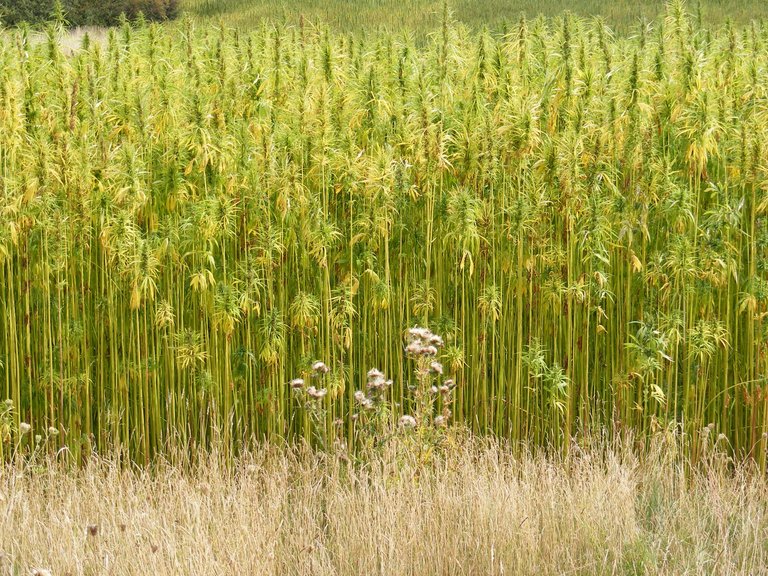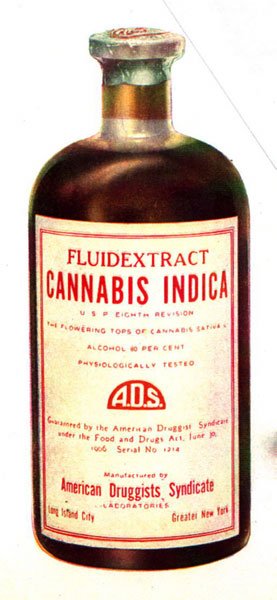Yesterday (technically in the wee hours of this morning), I released part one of a short series on cannabis and hemp, which sought to help readers understand the differences between the three genus of cannabis and know what makes a plant hemp vs. cannabis. I'm continuing with my posts for Hemp History Week, delving into the 6,000 year history of hemp.

Cannabis has been with humanity since our very origins, and is one of the first plants to be cultivated by mankind, with hemp clothing being found in tombs dating to 4,000 BC. This lengthy history has given humanity a very long time to play around with various ways to bred cannabis to achieve a myriad of possible outcomes. It is believed that cannabis originated in central Asia, somewhere in India or China, and was quickly carried around the world with human migrations. While cannabis fibers were the primary harvest, it is believed that ancient peoples also ate the nutrient dense hemp seeds, and knew of the medicinal benefits. The first written record of cannabis' medical uses is in China, during the second century AD, where an herbalism book mentions the creation of an alcohol tincture. Later on, during the Ming dynasty, the scientist, doctor, and herbalist Li Shizhen wrote about cannabis' medical benefits in the Bencao Gangmu, his Compendium of Materia Medica, widely regarded as the most comprehensive text on traditional Chinese medicine.
Cannabis spread across the Silk Road to Europe, where it was bred primarily for industrial uses, such as making the sails and ropes that the Spanish conquistadors needed to sail to the New World and bring cannabis seeds with them, spreading them to the Americas (perhaps for the first time). The first American Colonists also heavily valued hemp for the amazing potential it had as a source of food, fuel, fiber, clothing, and much more. In 1619, Virginia colony passed a law requiring every farmer to grow hemp, soon after hemp was able to be exchanged as legal tender. Domestic production flourished, and by the end of the 19th century, cannabis was one of the most commonly used medicines, found in all manner of tinctures and other products. The widespread use of cannabis in medicines helped lead to the passage of the 1906 Pure Food and Drug Act, the first time labeling of cannabis and other ingredients would be required.

The Mexican revolution of 1910-1920 caused a massive wave of Mexican immigrants to cross the border into America, seeking refuge from violence and bringing cultural habits of smoking cannabis with them. Cannabis use became associated with immigrants and those in the lower classes and anti-drug campaigners used racially charged language to advocate for cannabis prohibition, now referred to as marijuana (or the anglicized 'marihuana'). During the Great Depression, crime rates increased and much of this crime was attributed to cannabis smokers and those in the lower classes, building to a crescendo with the release Reefer Madness in 1936. During this same period, WWI began and Woodrow Wilson instituted a war-time prohibition in order to save grain for food, which was expanded by Congress into the 18th Amendment in 1917, under pressure from the temperance movement. With the creation of the Federal Bureau of Narcotics in 1930, and the appointment of Harry Anslinger as their first Commissioner, federal prohibition was expanded from just alcohol to include narcotic drugs like opiates and cannabis. When alcohol prohibition ended in 1933, the focus shifted to marihuana prohibition, and support was generated to pass the Marihuana Tax Act of 1937. While the word marijuana had been used for a couple decades at this point, many in Congress did not realize it was the same plant as hemp, and voted for it without even knowing they were making hemp illegal.
A lot can change in a couple of years, and on December 7th, 1941, Pearl Harbor was bombed and America entered WWII. Japan knew the strategic importance of hemp fiber, in making ropes, uniforms, and all manner of supplies America would need to survive the war, so the Japanese acted fast to cut off America's supply to Indian jute and Filipino hemp. In response, the US Department of Agriculture released the film Hemp for Victory in 1942, which encouraged farmers to grow as much hemp as possible and the USDA even gave seeds and draft deferments to farmers willing to stay home and grow hemp. Thanks to this massive influx of hemp seeds, wild cannabis can be found growing all over America, even to this day. Once WWII was over, the USDA ended the program and cannabis became illegal once again.
Throughout the 40's and 50's America saw harsher and more restrictive drug laws passed by states and by the federal government, these stricter laws did not dissuade The Beat Generation and other arbiters of counterculture from continuing to smoke marijuana. Counterculture use of cannabis increased in the 1960's as drug laws began to relax. In 1965, Professor Timothy Leary, a well-known drug researcher and counterculture icon, was found in possession of cannabis and, in the case of Leary vs. US (1969) he successfully used the 5th Amendment to strike down the Marihuana Tax Act of 1937. The Leary decision led to a period of a few months where America had no federal laws making cannabis use illegal, until Congress passed the 1970 Controlled Substances Act (CSA), creating the current tiered framework America still uses today. The CSA was unquestionably the law of the land until 1976, when a serious question was posed for the first time – do individuals have a right to use cannabis medically? In the case of Randall vs. US (1976), a federal court answered that question in the affirmative, for the first time a federal court agreed that there was a medical use for cannabis and that Robert Randall had a valid medical reason to use it. This case birthed the Investigational New Drug Program, the federal medical cannabis program that continues to this day, but was closed to new applicants by George H. W. Bush in 1992. Currently, there are only two patients still living in this program, Irvin Rosenfeld and Elvy Musikka.
It was only four more years until California became the first state anywhere in the world to create a medical cannabis program by passing Proposition 215. Jack Herer, author of The Emperor Wears No Clothes, was instrumental in passing Prop 215 and in general, being the driving force behind the hemp revival in America. California was soon followed by more states, and by 2015 over half of the states in America have some type of medical cannabis program on their books. In 2010, California attempted to lead the way once again by passing Proposition 19, an effort to legalize recreational cannabis which came 4% away from passing and set the stage for Washington and Oregon to legalize adult-use of cannabis in 2012, only two years later. Now, in 2017, the amount of adult-use states has risen to eight (including California), and there are 29 medical cannabis states, approaching the magic number of the 37-state majority needed to pass a constitutional amendment.
The biggest obstacles to cannabis legalization now are the lack of scientifically-accepted research on it, due to decades of prohibition policies preventing that research from being done, and the age-old arguments of protecting kids. It is hard to say what the future of hemp is, but it is undoubtedly going to remain a part of human culture as it has been for the past 6,000 years.
Congratulations @mrcolbert! You have completed some achievement on Steemit and have been rewarded with new badge(s) :
Click on any badge to view your own Board of Honnor on SteemitBoard.
For more information about SteemitBoard, click here
If you no longer want to receive notifications, reply to this comment with the word
STOPIf you want to support the SteemitBoard project, your upvote for this notification is welcome!